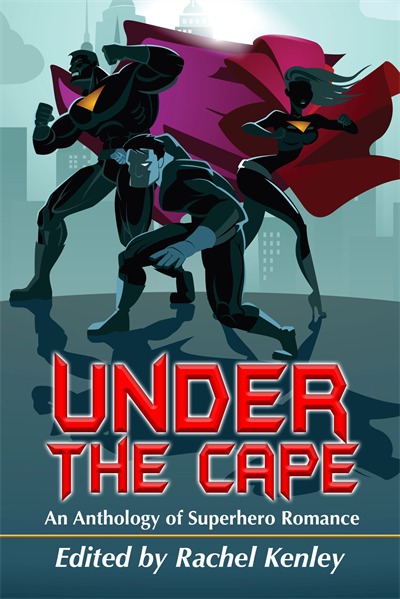Under The Cape is a romance anthology about superheroes, or a superhero anthology about romance depending on which story you’re reading. The anthology includes different sexualities, which is an aspect I particularly liked, though it did not delve too deeply beyond having m/m, m/f, and f/f pairings. Moving forward with this review, I will be referring to the pairings as they are listed in the anthology index, though I do recognize there is concern using the M and F labels, particularly when it comes to the intricacies of gender (which does not come up in this particular anthology).
The anthology was assembled during the pandemic, and a portion of the sales will be donated to the CDC foundation, which I also thought was a nice gesture.
Though the superhero genre did not start off this way, more recent superhero fare tends to support the state, whether that’s in increased surveillance, devoting wealth/resources to weapons in protection from the other (such as extraterrestrials, opposing government entities, etc), or simply catching so-called criminals for the cops. I was curious how Under The Cape would interact with these ideas, and for the most part received pretty standard fare. Some of the villains were purposely silly to the point where I could not take them seriously (and I believe that was the authors’ intent), and some heroes stopped crime, but very few stories delved into questioning why crime happens, and how their efforts were, at best, reactive and/or harmful. I do realize the point of the anthology is romance, but I think we can still have that while also asking tougher questions from the superhero thematic as a whole.
One story, “Supergay,” did portray a “villain” who was actually stealing artifacts from museums and returning them to the countries from which they were originally stolen, and very briefly touched on decolonization. Decolonization can take many different forms, and I would not put the burden of portraying multiple facets on a single story, but I do wish there had been more stories asking similar questions within the anthology as a whole.
“Time For No Mercy” introduced someone, again as a villain, set against Captain Courage who is revealed to be paid by various corporations. I really wanted to like this story because it did introduce complications and nuance to someone who could very easily be a stand in for an American golden boy. This neat exploration is undercut by the scientist also talking about how she was going to create an aerosol birth control that would affect all women — which is just another way to take away a person’s choice (and doesn’t really take into account that trans people exist) and felt especially off key due to the history of forced sterilization in the United States. Unfortunately, when bad guy Captain Courage does bring up the consent issue with that plan, the narrative uses the moment to reveal that multiple complaints were lodged against him for not procuring consent himself. Essentially the feminist message, and even the sweet f/f romance the story elevated, rang hollow and performative, and left out a lot of people. It felt especially dissonant because I wanted to support the doctor because she was trying to get his wife out of a bad situation, while also trying to save the world in a variety of ways but her world view is never challenged. The monologue is essentially included so the audience knows the author is about to do a switcheroo on who’s the villain and the hero in this story without further inquiry on what might, actually, constitute a feminist action.
So that’s the superhero part of the anthology–what of the romance? I did like that the anthology was divided between sweet and sexy. My favorite stories were ones that focused primarily on a pair where the superheroes facilitate the relationship. “No Words Spoken” is a great example of this. Overall, I did enjoy the f/f or m/m stories more than the m/f ones, but I’m also slightly biased in that regard. I appreciated the incorporation of queer people into a genre known for its happy endings.
That said, (I debated including this as I noticed it across multiple stories and authors) I noticed that attraction in both f/f and m/f stories focused on the same elements (the shape of a woman’s body, for example). It felt odd to me because the anthology as a whole seemed to indicate that attraction is universal — that attraction from a woman for a woman is interchangeable with attraction from a man for a woman. This has not been my experience as a lesbian, but ultimately I know I am one person in a very large and diverse community. This could indicate a story not matching my experience (which is okay!) or opportunities for growth in the romance genre when it comes to gay couples.
Overall, the m/f stories were mostly enjoyable on their own. I didn’t much care for how several of the stories relied on overworn tropes between men and women. For example, “Flying Fast, Falling Hard,” relies on a very disciplined woman clashing with a guy who’s more casual and fun. “Your True Self” which depicts a doctor in a relationship with his patient. Forbidden love, sure, but also some questionable power dynamics in play. I feel the cover does a great job encapsulating my feelings about the m/f pairings: it looks great, but why is the woman drawn like that and trying to do superhero work in high heels?
The writing voice varied from author to author, and some were better than others (to be expected in an anthology). It had a nice blend of third and first person, though Foolproof utilized two perspectives each using first person without necessarily having a unique voice to justify that particular choice.
Overall, this is a fun, easy, and unchallenging read, perfect for a long weekend where you want to treat yourself.
